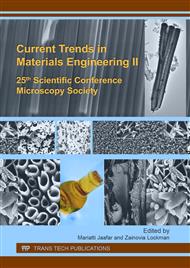p.202
p.206
p.211
p.215
p.220
p.224
p.228
p.232
p.236
The Effect of Addition of Polysaccharide Materials on the Morphology of Freeze Fracture Surface of Natural Rubber Latex Films
Abstract:
Sago starch, amylose and amylopectin were used as fillers in natural rubber (NR) latex compounds. The compound was prevulcanized at 80 °C until chloroform number 2-3 was achieved. The effect of the fillers on the NR latex film mechanical properties (tensile properties and tear strength), and crosslink density were obtained. The fractured surface of the films was captured via scanning electron microscope (SEM) Zeiss Supra 35 VP. The results shown the addition of fillers reduced the tensile strength and elongation at break of the NR latex films but increased in the films tear strength. The swelling index of the films increased, indicating lower crosslink density possessed by the polysaccharide filled films. From the SEM micrograph, the addition of sago starch and amylose produced an uneven freeze fractured surface similar to the control starch films. Meanwhile, for films reinforced with amylopectin, the smooth surface is obtained indicating poor interfacial adhesion between filler and NR latex matrix.
Info:
Periodical:
Pages:
220-223
Citation:
Online since:
September 2017
Authors:
Keywords:
Price:
Сopyright:
© 2017 Trans Tech Publications Ltd. All Rights Reserved
Share:
Citation:


